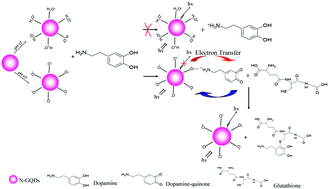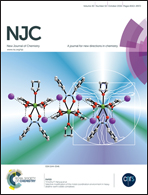A dopamine-modulated nitrogen-doped graphene quantum dot fluorescence sensor for the detection of glutathione in biological samples
Abstract
A dopamine-modulated nitrogen-doped graphene quantum dot (N-GQD) system was explored to develop a fluorescent sensor based on a chemical redox mechanism for the facile, sensitive and selective detection of glutathione (GSH) in biological samples. Dopamine could self-polymerize to poly dopamine-quinone and snap to the surface of N-GQDs to form a thin film in an alkaline environment, leading to quenching of fluorescence due to fluorescence resonance energy transfer (FRET). Subsequently, GSH can reduce dopamine-quinone, and inhibit the electron transfer process of N-GQDs and quinone, which results in the recovery of the fluorescence of N-GQDs. The fluorescence sensor showed a response to GSH within a wide concentration range of 0.20–85 μM, with a detection limit of 43 nM. The sensor was successfully applied to detect GSH in human urine and serum samples with a recovery range of 96–103%.


 Please wait while we load your content...
Please wait while we load your content...